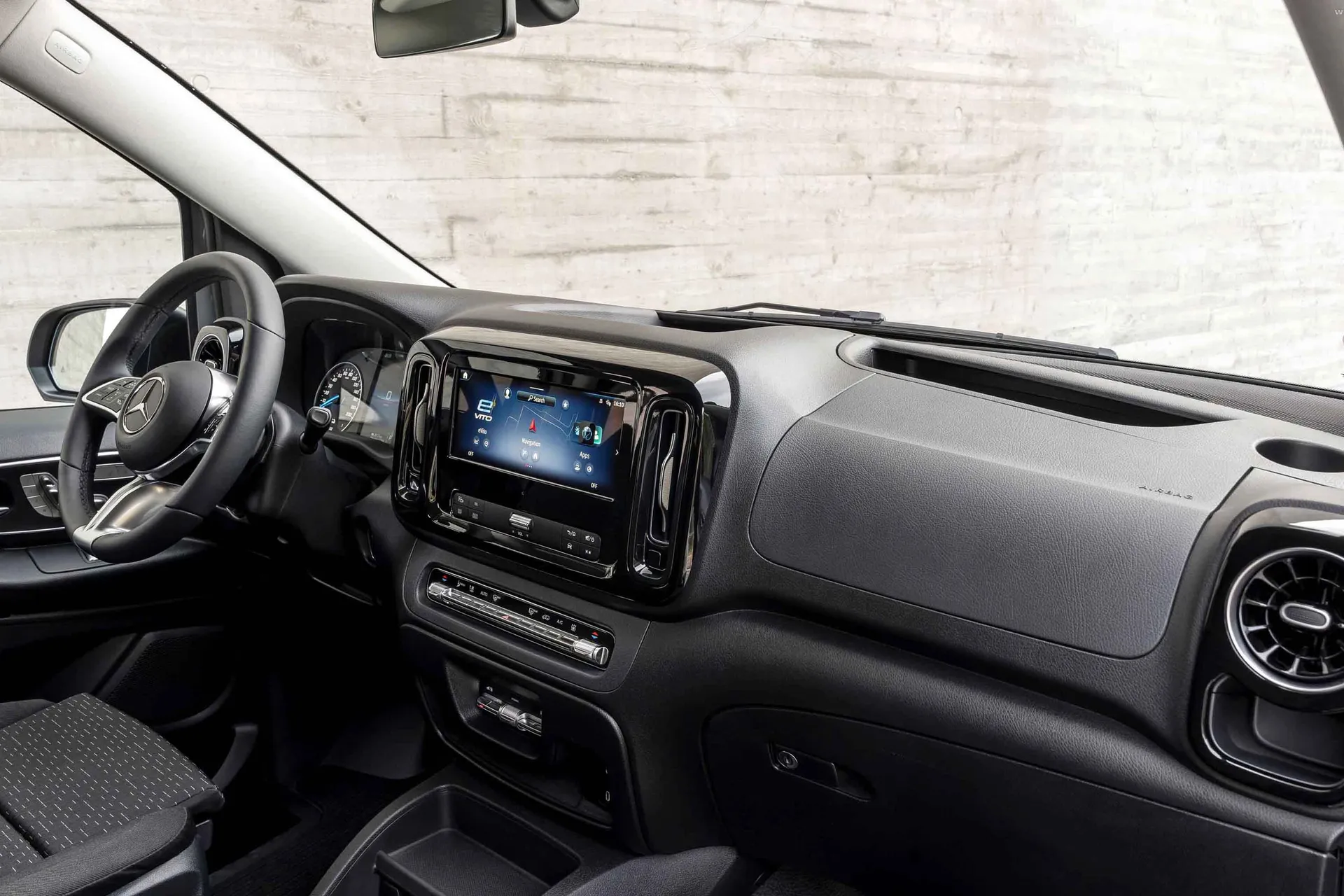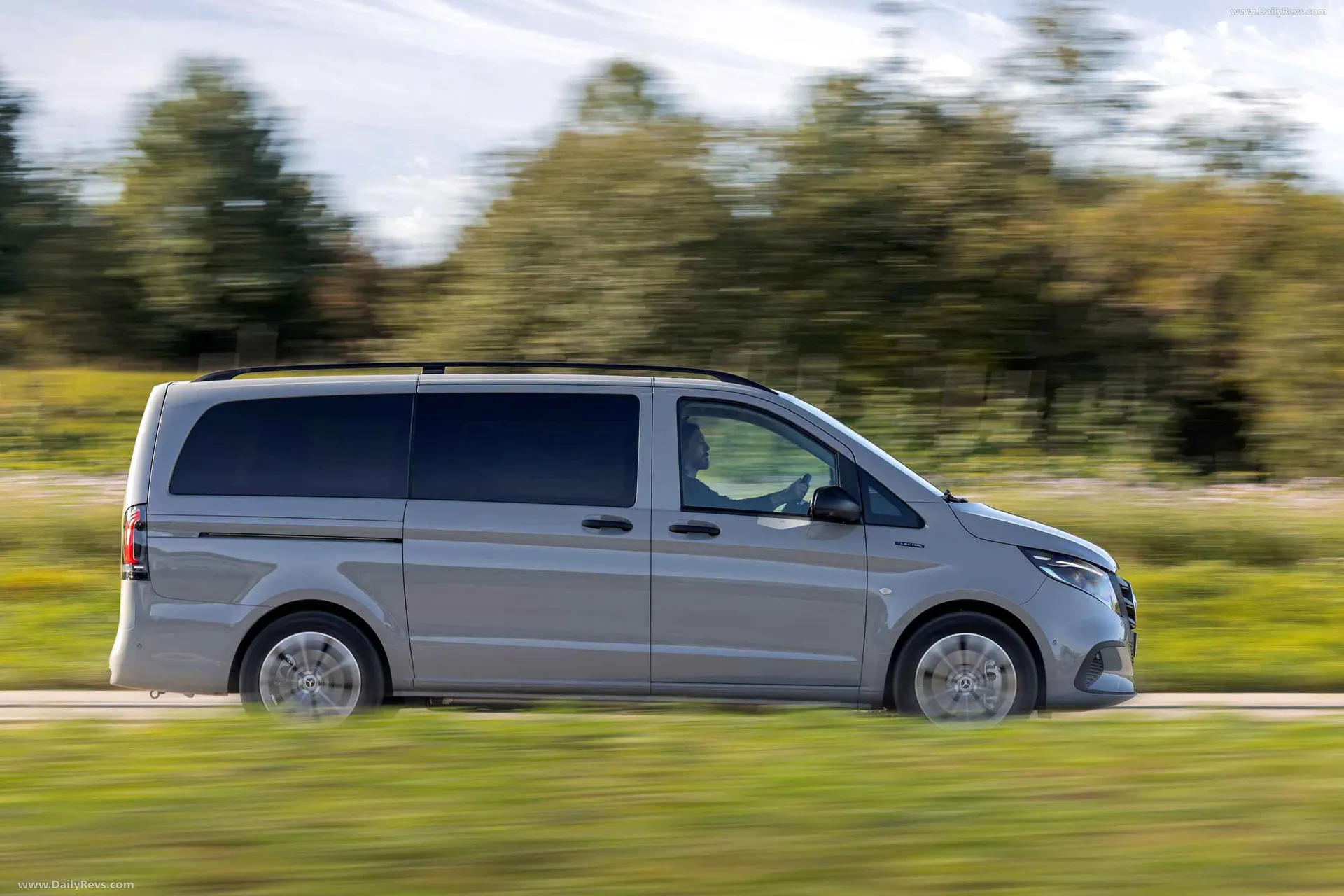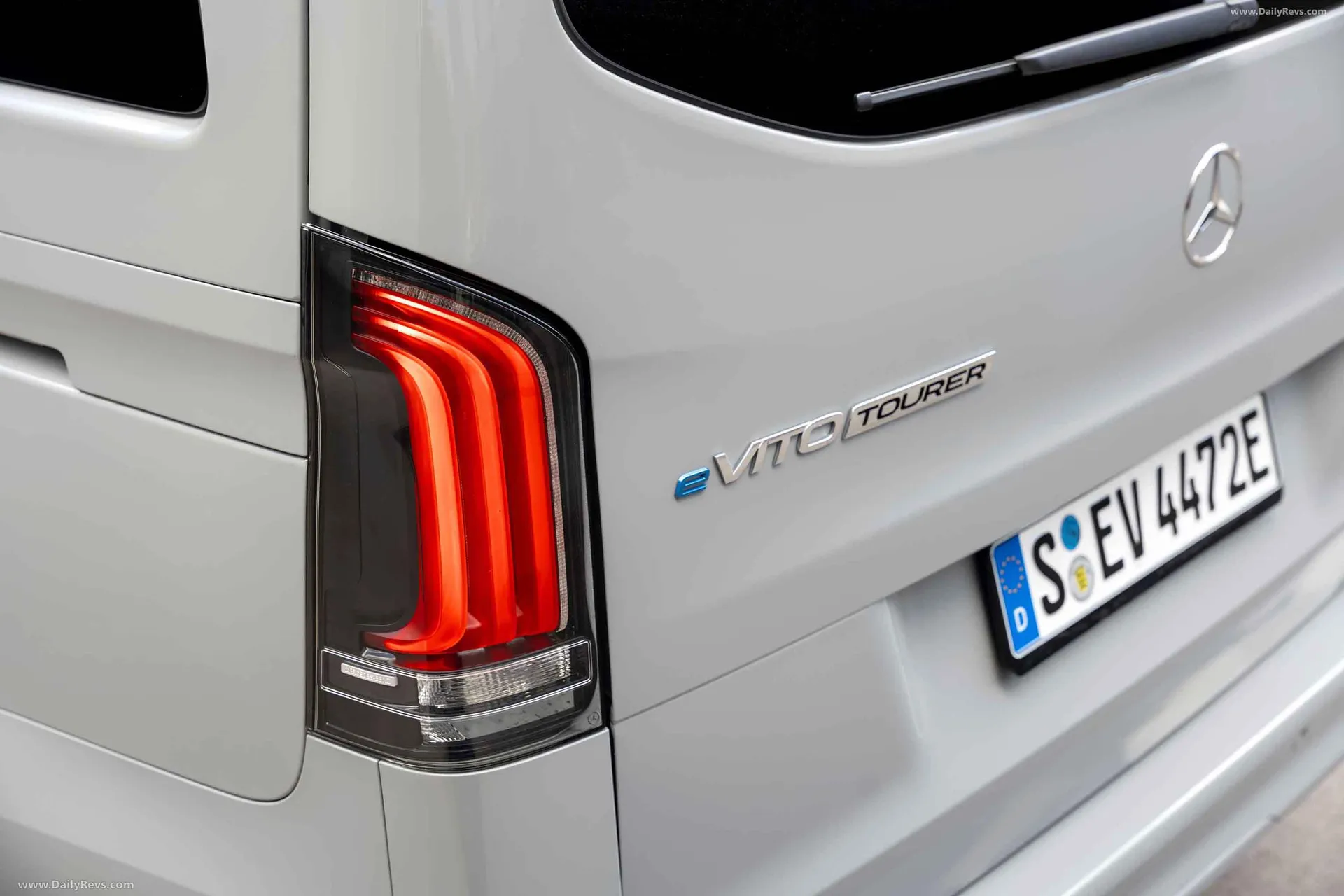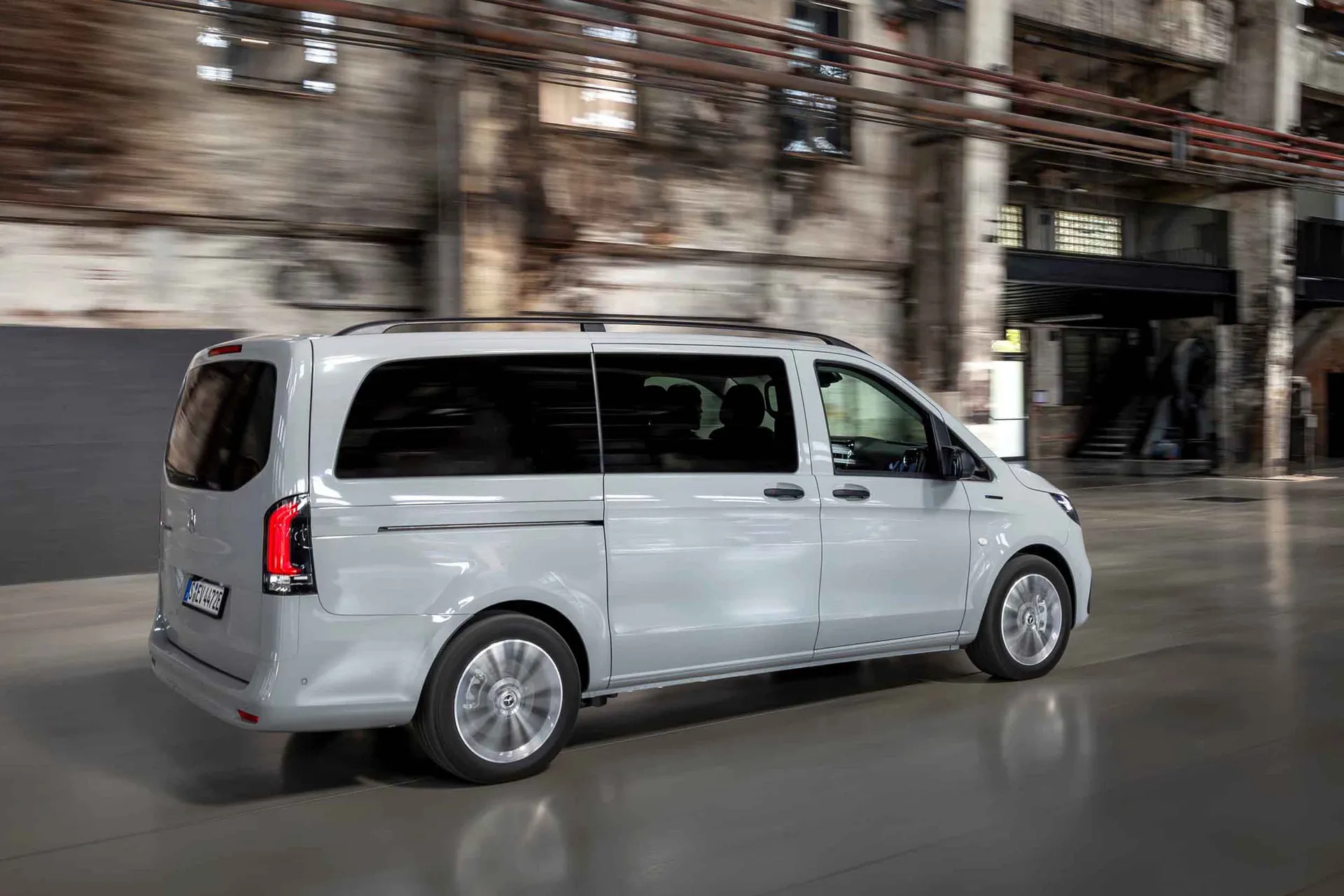Mercedes-Benz Vito Tourer Review 2025: Price, specs & boot space
Written by Matt Robinson
Quick overview
Pros
- Feels very plush for a van
- Electric eVito is relaxing to drive and quite quick
- Good on-road manners
Cons
- Expensive, especially in eVito form
- Removing and replacing the seats isn't easy
- Touch-sensitive steering wheel buttons are tricky to use
Verdict: Is the Mercedes-Benz Vito Tourer a good van?
"The Mercedes-Benz Vito Tourer is the poshest van-based people carrier around, with a plush-feeling interior that oozes quality. You do pay a premium for all that, though, so you'll need to think hard if the extra feeling of luxury is worth it for you."

With the panel and crew versions of the Vito feeling more premium than other vans, it should come as no surprise that the Vito Tourer is posher than the average van-based people carrier.
It's a little long in the tooth, with the current generation kicking around since 2015. That could be a bit of an issue for the Vito Tourer when it has a pair of much fresher rivals to worry about – the Volkswagen Transporter Shuttle and the Ford Tourneo Custom, which are much the same apart from badging and styling.
Mercedes-Benz van salespeople can rest a bit easier, however, because the Vito range as a whole received a substantial update in 2024 that brought the van much more up-to-date in terms of its interior and its standard safety equipment.
Not everything should be considered an improvement, however, with Mercedes-Benz ditching the perfectly useable steering-wheel mounted buttons of the older model with touch-sensitive pads that are a pain to use. Which seems like a shame.
The Vito Tourer seats up to nine, although it is possible to spec it with the three abreast front seating for two single seats to reduce that capacity to eight. The second and third rows can be removed should you want to treat the Tourer more like one of its panel van and crew van siblings. Interior room can also be maximised by speccing the longer L3 variant, although you will end up sticking out of the average-sized UK parking space.
There's now the option of an eVito Tourer, which gets a lot more power and a bigger battery than the eVito panel van. It's not cheap, though. The diesels, too, are priced higher than the aforementioned Ford and Vauxhall, so you are paying extra for the posher badge and additional feeling of luxury.
Looking for a used van for sale? We've got 100s of Mercedes-Benz Approved Used Cars for Sale for you to choose from, including a wide range of Mercedes Vito vans for sale.
Is the Mercedes-Benz Vito Tourer right for you?
If you need to carry seven or eight passengers but want something with a bit more badge kudos and a slightly more upmarket feeling than something like a Citroen SpaceTourer, quite possibly. Yes, the Vito Tourer is more expensive than less fancy rivals, but it does justify the premium.
What’s the best Mercedes-Benz Vito Tourer model/engine/battery to choose?
For the panel van, we recommended going for the base-spec Pro, but given that the Vito Tourer is more likely to be something other than a work vehicle, you might well want to upgrade to the Select with its body-coloured bumpers for a less utilitarian look. We'd probably stick with the shorter L2 if possible, because it should fit into the average UK parking space.
Then, it's a case of deciding whether or not you want the electric eVito Tourer instead of a diesel. It's difficult to say if one is 'better' than the other – a lot of it is going to come down to how easily you can integrate an EV into your life. The eVito is certainly very relaxing to drive and provides effortless performance, but its range of up to 221 miles (which might equate to a good chunk less than 200 at colder times of year) won't cut it for everyone. It's also a lot more expensive, and no longer gets out of paying vehicle tax.
If you do opt for the diesel, your engine choice is narrowed slightly compared to the panel van. We'd be tempted to opt for the more powerful 116 engine, which provides a reasonably sprightly 163PS. If you're going to be regularly filling most or all of the Vito's nine seats, the pokier engine will mean you're not left flooring it just to get up to the national speed limit with any vague sense of urgency.
What other vans are similar to the Mercedes-Benz Vito Tourer?
Plenty of manufacturers offer people carrier versions of their vans, but there isn't as much choice as you might think, because a lot of them are essentially the same thing besides branding and light styling differences.
The new T7 Volkswagen Transporter Shuttle, for example, is now a 'badge-engineered' version of the Ford Tourneo Custom, the passenger version of the Ford Transit Custom. Then you've got the Stellantis group, where all sorts of sharing goes on, meaning the Citroen Spacetourer is pretty much the same van as a Peugeot Traveller and a Vauxhall Vivaro Life. Toyota isn't even a part of Stellantis, yet offers its own version of those vehicles, called the Proace Verso.
The Mercedes-Benz is the plushest option of all these sorts of people-carrying vans, though. And although the VW Transporter/Ford Tourneo Custom cousins are a lot fresher, the Merc is a similar age to the Stellantis (and Stellantis-adjacent, in the Toyota's case) horde.
Things get plusher still in the Mercedes-Benz V-Class, which is based on the Vito. It's even more expensive than the Vito Tourer, though.
Comfort and design: Mercedes-Benz Vito Tourer interior
"The Vito Tourer is plusher inside than the average van-based MPV, but it loses points for the irritating, tricky-to-use touch pads on the steering wheel, which were introduced as part of the most recent update."

The Vito range as a whole gained a much smarter-looking interior in 2024, including a particularly snazzy steering wheel. Perhaps the nicest steering wheel of all fitted to a van. The problem is the button pads on either side – they replace, well, actual buttons, but don't work anything like as effectively.
It involves a mix of touch and swipe controls, making it frustratingly easy to do something unintended. They're probably even more annoying than the touch pads Volkswagen started fitting to cars a few years ago, a move it's ended up reversing due to negative customer feedback. Mercedes-Benz feels a bit behind the curve in this sense.
When you're not pushing buttons you didn't mean to, the Vito Tourer offers a pleasant space to spend time. The controls are all in easy reach and placed logically, while the seating position is comfortable and offers plenty of adjustment for both the seat and the steering column.
Unlike a lot of Mercedes-Benz's passenger cars, the Vito still, thankfully, retains physical climate controls, positioned a little below the infotainment screen. Selecting drive, neutral, reverse and park, meanwhile, is done using a stalk on the right side of the steering column, with the one on the left tasked with operating both the indicators and the windscreen wipers. If you're used to one stalk for each, don't worry, you soon get used to this setup.
Rather than a digital instrument cluster, you get traditional analogue dials with a 5.5-inch TFT between them providing plenty of information. In the eVito, the rev counter is replaced with a dial showing how much power the motor is outputting from 0-100%.
Quality and finish
It'd be wrong to expect something that feels as fancy as a Mercedes-Benz passenger car in a van setting. These vehicles are built to withstand a far harsher life, which means you get more in the way of hard-wearing plastics rather than an abundance of soft-touch surfaces.
That being said, the Vito Tourer does feel a cut above other vans. The steering wheel, ignoring those silly touch-sensitive pads, feels very premium, and although we often moan about shiny black plastic for being scratch and fingerprint prone, it's used sparingly and to good effect here to uplift the cabin.
Most importantly, everything feels put together well, and as though it'll still look good after many thousands of miles of use.
Infotainment: Touchscreen, USB, nav and stereo in the Mercedes-Benz Vito Tourer
The infotainment system was starting to feel like old hat in the pre-update version of the Vito, but the new version, used across the entire range, including the Touring, is more like it.
The 10.25-inch screen is on the smaller size by modern standards, and this results in some of the icons being rather diminutive and not the easiest to use when in motion. It's otherwise a good setup, though, with smart colour schemes, a responsive touch surface and a logical menu system.
The audio system is decent enough. There's no option to upgrade it, before you get excited about the thought of speccing one of the lovely Burmester systems available in a lot of Mercedes-Benz cars.
For keeping your devices charged, there are two USB-C ports in the front and a wireless phone charging pad. Android Auto and Apple CarPlay connectivity are included as standard.
Space and practicality: Mercedes-Benz Vito Tourer cargo space
The Vito Tourer generally seats up to nine in three rows of three, but it is possible to spec it as an eight-seater. Meanwhile, the L3 version of the eVito Tourer is supplied as an eight-seater.
The Vito Tourer is available as an L2, which is 5,140mm long, and as a 5,370mm-long L3. Think carefully if you really need the longer one, as it'll hang over the edge of the average UK parking space, and could poke out into the pavement if you've a small single driveway space.
Maximum payloads range from just over 700kg in the eVito Tourers to 917kg in a Pro L2 114. The Vito Tourer has a load space of up to 1,700 litres, which you can expand considerably by ditching either or both of the seat benches.
This is easier said than done, though. The third row is one complete unit, and as such, it's extremely heavy and requires at least two people to remove and reinstall, and even then, it's a faff trying to get it back in since it's near enough the width of the load bay. We also had a bit of difficulty getting the bench to lock back into place when we gave this a go.
It's slightly easier for the middle row, which is split in two, so that only a single seat needs to be rotated forward to allow access to the third row.
Handling and ride quality: What is the Mercedes-Benz Vito Tourer like to drive?
"Although it's a Mercedes-Benz, you can't get into a Vito Tourer expecting it to ride like an S-Class. It's comfortable as far as van-based people carriers go, though."

Although its main priority is carting around passengers rather than cargo, you need to remember that the Vito Tourer is a van at heart, and that's evident in the way that it drives. Which is...rather like a van, funnily enough.
That said, it handles quite tidily. Yes, there's some body roll, but not as much as you might expect. The ride comfort is busier than you might experience in a car-based people carrier, but the suspension deals with lumps and bumps effectively enough.
A quirk of choosing the all-electric eVito over the diesel versions is the handling balance changes. That's because the eVito Tourer has its motor at the front axle, whereas the diesel engines power the rear wheels. This means that when pushed, the eVito Tourer will wash wide at the front (what's known as understeer), rather than stepping out at the back (oversteer). In day-to-day driving, though, you're not going to notice the difference.
What's of more use is the Vito Tourer's reasonably tight turning circle. When combined with well-weighted and responsive steering, it makes for a van that's reasonably easy to manouevre.
What engines and gearboxes/batteries and motors are available in the Mercedes-Benz Vito Tourer?
The Vito Tourer's engine line-up is more limited than that of the panel/crew versions. It misses out on the 190PS '119' model, so you're left to choose between the 114 (136PS) and the 116 (163PS), and you can only combine those with the nine-speed automatic gearbox here, with the six-speed manual not available.
Although we haven't tried either option in the panel van, we got on well with the 190PS version we've tested separately, which at its core is the same base engine as the other two – a 2.0-litre, four-cylinder diesel engine. Although such units aren't known for refinement, this one is relatively smooth. The automatic gearbox is slow-witted, though, particularly when you want to kick down a gear and accelerate a bit quicker.
So far, we've only trialled the Tourer as an eVito electric van. Again, there's a distinction here between the Tourer and the panel/crew vans, with the latter having to make do with a 60kWh battery pack and a 116PS motor. Presumably because the Tourer is expected to do longer trips more often than a panel van, which is more likely to be used more locally by a tradesperson, the Tourer has a 90kWh battery.
This increases the range, and you also get a much more powerful motor outputting 204PS and 362Nm of torque. The 0-62mph time is 12 seconds, which doesn't sound anything too special, but the instant arrival of that torque means that the eVito feels quicker than that figure suggests.
There's an effortlessness to the way it gets around, and without a four-cylinder diesel engine grumbling away, the eVito Tourer is super relaxing to drive. There's even a Sport mode, although it doesn't feel hugely different. More obvious is the switch to Eco, which noticeably sandbags the electric powertrain.
Refinement and noise levels
As already mentioned, the diesel engine isn't too noisy, although it can get quite vocal when worked hard. You'll have no such issue with the eVito Tourer, whose electric motor only makes the faintest of whirrs even at full throttle.
Even without an engine to compete with wind and road noise, neither is at a noticeably high volume on the move. Again, we'll have to add our 'for a van' caveat here.
Safety equipment: How safe is the Mercedes-Benz Vito Tourer?
For the 2024 update, the Mercedes Vito range was blessed with a greater level of standard safety equipment. Autonomous emergency braking, a driver attention monitor, blind spot assistance, lane assistance, speed limit assistance and 'eCall' (which automatically alerts emergency services if you get into an accident) are all included at no extra cost.
While Euro NCAP used to rate light commercial vehicles as Bronze, Silver, Gold, or Platinum, but the safety body has switched to a star rating system much like its car tests. The Vito's Platinum score has become a five-star rating, therefore. The pre-update van with fewer safety systems managed only a Silver rating, now equivalent to three stars out of five.
MPG and fuel costs: What does a Mercedes-Benz Vito Tourer cost to run?
"Regardless of your chosen engine, the fuel economy of your Vito Tourer is going to vary little."

In fact, the 114 L2 Pro and 116 L2 Pro offer exactly the same figure of 40.4mpg. Those are the two most economical versions, while the joint thirstiest, the 116 L2 and L3 Select, aren't far behind at all at 39.2mpg.
If anything, you might well get better fuel economy out of one of the more powerful versions, as it won't need to be worked quite as hard to make decent progress. But we wouldn't let fuel economy alone steer your decision, given the similarities.
The eVito Tourer can travel up to 221 miles on a full charge according to the combined WLTP figure. What you actually manage will vary wildly depending on ambient temperature and the kind of driving you're doing. At colder times of year and with a heavy bias towards motorway and dual-carriageway driving, you likely won't get anywhere near the 200-mile mark.
Mercedes-Benz eVito Tourer charging times: How much does it cost to charge?
The eVito Tourer has a fast-charging rate of 110kW, which is quite a bit better than the 80kW managed by the panel and crew versions, while slightly behind the 125kW offered by a Volkswagen Transporter Shuttle Electric.
Plugged into a fast enough charger, you'll be able to take the battery from 20 to 80% in 40 minutes, assuming optimal conditions. Public chargers can be extremely expensive, though – such a stop could cost you as much as £40 or more and the pricier stations.
Where possible, then, you'll be wanting to keep your eVito Tourer charged at home. Fully charging at home will cost somewhere between £20 - £25 on an average tariff, but there are variable products available that offer a lower per kWh rate at certain times of day, making it a lot cheaper.
When charging at home with a wallbox, you can expect it to take about 12 hours to charge to full from near flat. Using a three-pin plug isn't recommended, partly because it might not be good for your home electrical system, and also because it'll take at least three times as long.
Mercedes-Benz Vito Tourer reliability and warranty
Our usual source for reliability data is the HonestJohn.co.uk Satisfaction Index from our sister website, but it doesn't cover vans, making it tricky to judge the Vito for reliability. We can get a bit of a steer from how well Mercedes-Benz did as a brand, though, and on that front, it's a poor showing, with the German firm ranked as 30th out of 33 for reliability.
It should help that the current Vito is a proven model at this stage, however. Also, by opting for the eVito Tourer, there are fewer moving parts, which means there isn't as much to go wrong.
The warranty length of three years is pretty common, but more unusual is the offering of unlimited mileage cover during that time. Meanwhile, the eVito Tourer has a separate warranty covering the battery pack, which lasts up to eight years or 100,000 miles.
Mercedes-Benz Vito Tourer insurance groups and costs
The Vito range as a whole runs from group 27 to 44 of 50. The eVito is towards the upper end of that, which doesn't surprise us, as electric vehicles do cost more to insure on average, and the eVito also costs a lot more than its diesel equivalents.
VED car tax: What is the annual road tax on a Mercedes-Benz Vito Tourer?
The Vito Tourer is still considered a light goods vehicle, meaning it's £335 a year for Vehicle Excise Duty (VED). Electric vans are no longer exempt, so you'll pay that same rate even if you've opted for the eVito Tourer. Vans aren't subject to the premium car tax levied at vehicles costing more than £40,000, though.
Mercedes-Benz Vito Tourer price
"Assuming you're paying VAT on your Vito Tourer, you'll be paying upwards of £54,738 for the diesel version, while it's over £20,000 more for the cheapest electric one. Because it's been around a while, though, it is possible to pay a lot less for a used version of the current-generation Vito Tourer."

That £54,738 will get you the shorter Vito Tourer L2 with the 114 diesel engine. The price goes up to £56,004 for the longer L3 with the same trim/engine combination, while it's £ 56,844 for a Pro L2 116 and £58,110 for the L3.
It's quite a big jump to the cheapest Select grade van at £63,444, partly because it can't be combined with the lowest-powered engine – you have to have it with the 116 at least. It's then £64,710 if you'd prefer it as an L3.
Fancy the all-electric eVito Tourer? We hope you're sitting down, as it's a cool £76,962 for the cheapest, a Pro L2. It's £77,904 for a Pro L3, while a Select is £83,850 as an L2 or £84,792 as an L3.
If you're not fussed about the 2024 updates to the Vito Tourer, you could pay a fraction of the price for an earlier version. Beneath the rejigged face, it's largely the same as it has been since the third-generation model was launched a decade ago, meaning an early, higher mileage example can be bought from around £10,000.
The eVito Tourer is a much more recent addition, but we've seen some substantial discounts on pre-registered models, some of which are in the low five figures.
Trim levels and standard equipment
Like the panel van Vito, the Vito Tourer is offered as either a Pro or Select. The Pro has a decent offering of kit, including 17-inch alloy wheels, climate control, a leather steering wheel, 10.25-inch infotainment touchscreen, Android Auto/Apple CarPlay smartphone connectivity, a reversing camera and cruise control.
It looks quite basic, though, with unpainted bumpers front and rear. The Select looks a lot smarter thanks to a switch to body-coloured bumpers, and you also get power-folding door mirrors, LED headlights with automatic high beam, the parking package, a heated driver's seat, and a smartened up interior including ambient lighting.
Ask the heycar experts: common questions
What's the difference between a Mercedes-Benz Vito Tourer and a Mercedes-Benz V-Class?
How many seats does the Mercedes-Benz Vito Tourer have?
How much does a Mercedes-Benz Vito Tourer cost?
Get our latest advice, news and offers
Keep me updated by email with the latest advice, news and offers from heycar.
By submitting you agree to our privacy policy



